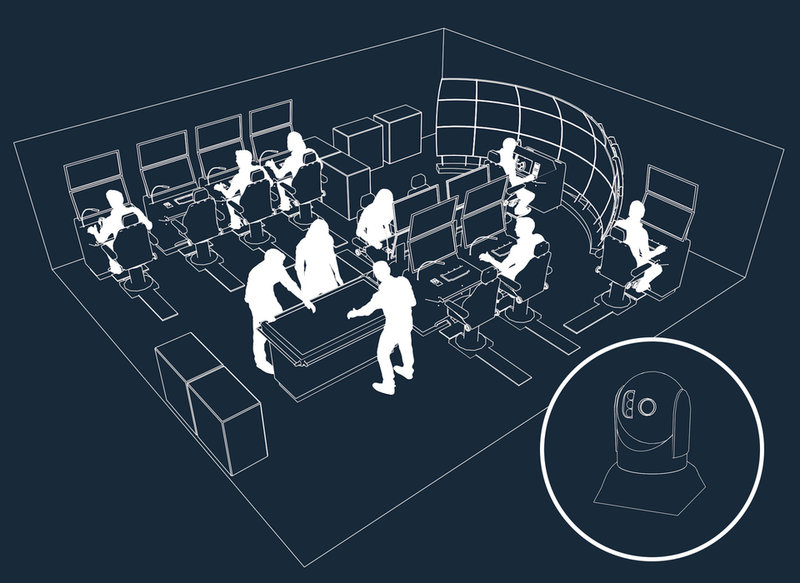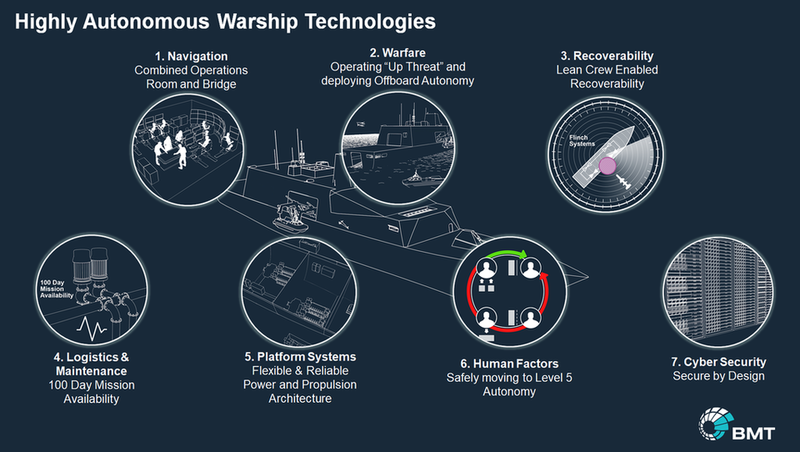Autonomy
BMT Group sets out vision for highly-autonomous future warships
BMT Group aims to bridge the gap to autonomy to enable safer, more secure operations with lean-crewed warships through characterising the future battlespace landscape and identifying relevant technologies. The company explains its 2040 vision to Norbert Neumann.
BMT Group aims to bridge the gap to autonomy to enable safer, more secure operations with lean-crewed warships through characterising the future battlespace landscape and identifying relevant technologies. The company explains its 2040 vision to Norbert Neumann.
Alexandra Stickings:
// Alex Giles, CCO at Iceni Labs
To automate or not to automate
Research and development lead at BMT Jake Rigby explains: “We want to keep humans doing what they’re really good at and let computers do what they are better at doing and focus on how we can pair these elements.”
But removing crew members from vessels entirely may not be an option just yet.
“We don’t see that [complete automation] happening in the near future. There is also the understanding of the ethical aspects of warships operating autonomously, whether that’s defending themselves or choosing whether to engage in fights. There is a huge hurdle to overcome in terms of trust of the supervisory systems,” BMT chief engineer Ian Savage says.
BMT is addressing these issues but the process takes time, and the company thinks it is important that systems that enable at least partial automation are integrated. It believes that transitioning towards a highly autonomous, lean crewed concept can provide improved operational capabilities while retaining asset flexibility by keeping a limited number of highly skilled personnel on board.
It can improve their quality of life and increase retention rates
Autonomy offers the potential of reducing the through-life cost of the platform and increasing reaction time.
Rigby explains: “If we look at hypersonic missiles or other new threats, a computer can pick out and track those things better than a human can.”
Removing personnel from the direct line of fire is another important aspect.
“It can improve their quality of life and increase retention rates because they could do some of the roles onshore rather than having to necessarily always be on the vessel,” Rigby adds.
In this future concept, there is no regular bridge on the vessel. BMT believes the navigation function can be performed using electro-optical sensors from a virtual steering position in a combined operations room and bridge deeper inside the ship.
This concept reduces the number of personnel on board, keeps them safer and frees up topside real-estate for weapons, communication equipment and sensors. Less personnel translate into lower operational costs and longer endurance.
Operating a vessel in theatre without personnel onboard poses potential limitations and dangers. If a scenario emerges that is not programmed into the computer, adapting the system to the new threat might be too lengthy or difficult. Having an optimised presence also means missions are capable of operating in GPS denied areas and need not rely so heavily on spoofed and jammed satellite connections, making ships less susceptible to pirate attacks.

// The navigation function would be performed, using electro-optical sensors, from a virtual steering position in a combined operations room and bridge deeper inside the ship. Credit: BMT Group
Recoverability
BMT technical experts identified and split the project into several key development areas. The recoverability aspect of the work focuses on the abilities that enable a lean-crewed vessel to respond during damage-control scenarios swiftly and flexibly.
Damage control traditionally relies on people-led firefighting, flood control and repair activities. These responsibilities can be difficult to automate. Savage, however, sees it as an opportunity.
“We can integrate robust system design with the ability to reconfigure itself on the damaged conditions. But that also links into platform systems and potentially maintenance and logistics,” he says.
The vision is about finding ways of pulling work together from across different areas. Savage believes functional requirements need to be integrated with other shipboard functions, such as CCTV oil mist and fire detection or fuel system pressure monitoring linked to pre-fire alarms. Situational awareness, therefore, would enhance the crew’s ability to focus on various aspects of the operation.
If a robust information and management system design is in place, lean crewed operation enables 100-day mission durations. Situational awareness also provides flexibility and a high level of system monitoring. Improved logistics and maintainability, in turn, expand recoverability.
Savage explains: “Because system monitoring gives you the ability to understand your system’s state under damaged conditions as well, those same sensors then provide you with potential real-time condition-based monitoring.
“You could do this from a facility ashore, onboard or both and allowing you to plan that kind of maintenance schedule around a specific port stop.”
Another focus area of the project is on the platform systems. BMT is looking into abilities for vessels to conduct some of their husbandry, maintenance and inspection autonomously. For instance, identifying and stopping leaks, reconfiguring according to a situation or reducing husbandry. But to get to those high levels of reliability, design principles, equipment selection, installation and commissioning practices will need to be maximised.

// BMT technical experts identified and split the project into several key development areas. Credit: BMT
Cybersecure by design
As intelligent systems across the ship create new digital interfaces and information sources that help the crew operate more efficiently, the very same systems invariably increase the threat surface area from a cybersecurity perspective. By definition, the ‘secure by design approach’ would ensure that cybersecurity principles are embedded at an early stage in the design.
Rigby claims the company is taking a new approach to solving this issue.
“What we've tried to do on cybersecurity is take a blank canvas, forget everything that we know about how networks are designed on warships today, and thought, ‘How could we design this system to be fully secure by design, and operated securely as well’,” he concludes.
// Main image: BMT Group has a vision for highly autonomous, lean crewed future warships. Credit: BMT
UK headquartered engineering, science and design company BMT is investigating solutions to integrate AI and intelligent systems into naval ship design. The technology will be able to process vast amounts of data and feed relevant information to the crew; being better informed will accelerate decision-making processes on the ship.
The company has a vision for the 2040 timeframe and beyond, but the concept is not about complete automation. The project is seeking solutions that reduce the number of people who need to be in a high-threat environment through a balance of autonomy and human operators. This concept is called lean-crewed.